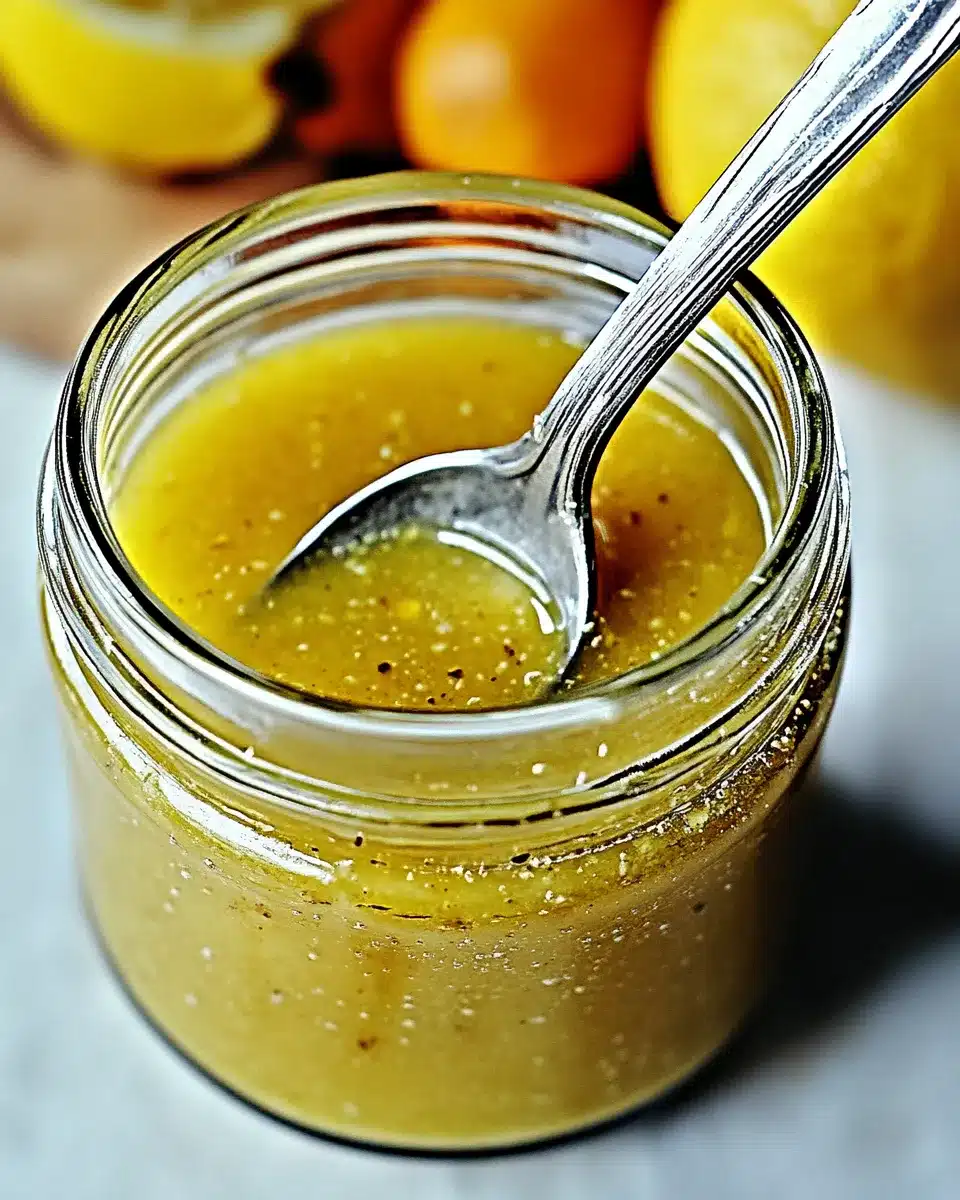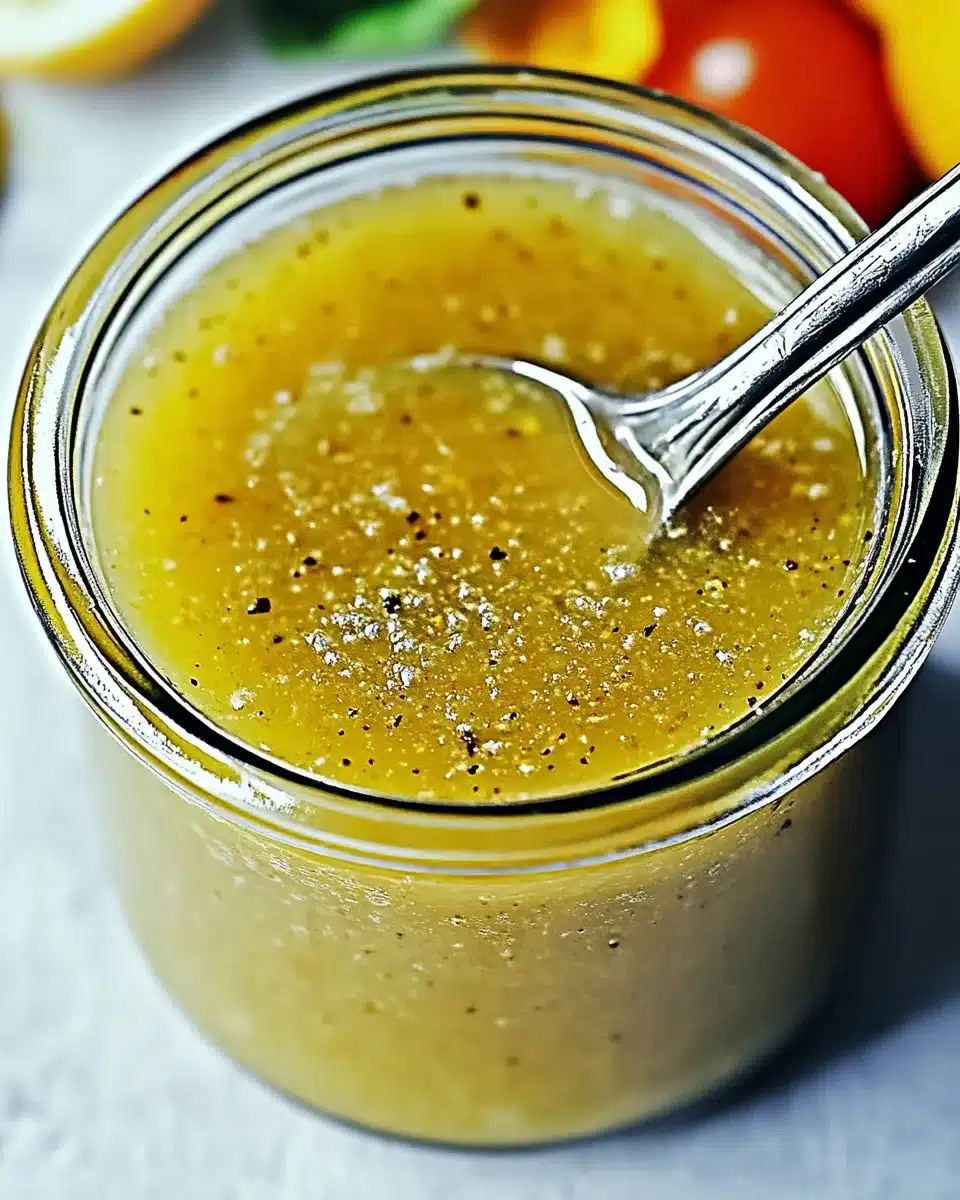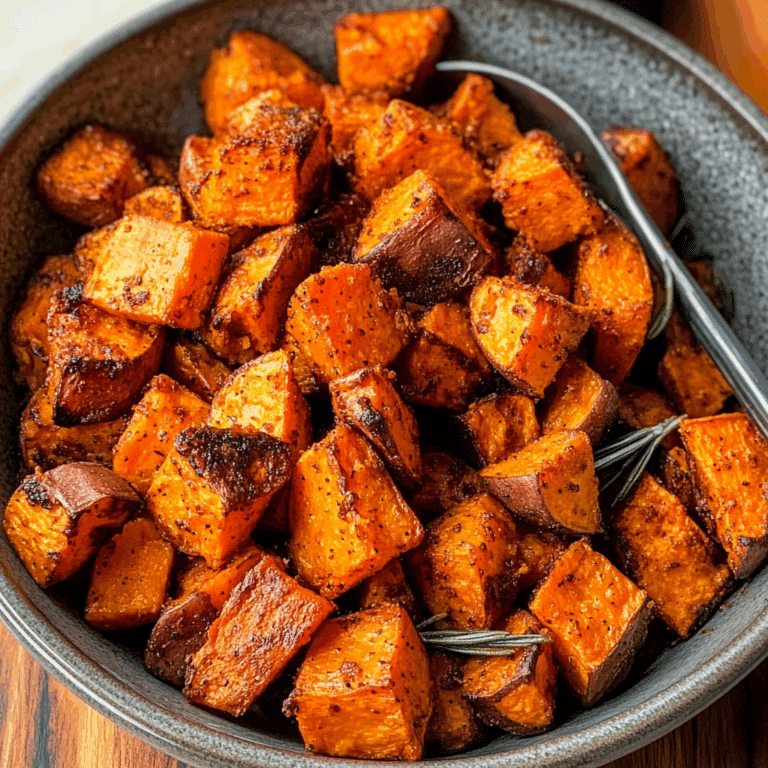Lemon Vinaigrette Recipe: Fresh & Zesty Flavor Made Easy

Are you ready to elevate your salads and dishes with a burst of tangy freshness? A Lemon Vinaigrette Recipe is your passport to a zesty flavor explosion that complements a myriad of meals. This bright and citrusy dressing not only sharpens the palate but also adds a delightful twist to grilled vegetables, seafood, and even roasted meats.
The beauty of this classic vinaigrette lies in its versatility; you can easily customize it to suit your taste preferences. Add a hint of honey for sweetness, a clove of minced garlic for depth, or even fresh herbs like basil or parsley for an aromatic touch. For those looking to experiment, try incorporating different acid components, such as apple cider vinegar or balsamic vinegar, to create a unique flavor profile.
To achieve the perfect emulsion, whisk the ingredients vigorously while slowly drizzling in the olive oil. With expert tips and variations at your fingertips, you can craft a dressing that will make any dish unforgettable!
Ingredients for Lemon Vinaigrette Recipe:
This delightful lemon vinaigrette is perfect for dressing up salads, drizzling over grilled vegetables, or enhancing any dish that could use a zesty boost. Here’s a comprehensive list of ingredients needed to serve 8–10 people:
Base Ingredients:
- 1 cup fresh lemon juice (approximately 4-5 medium lemons)
- 1/2 cup extra-virgin olive oil
- 1 tablespoon Dijon mustard
- 1 tablespoon honey or agave syrup (for sweetness)
- 1 teaspoon garlic, finely minced or grated (optional, for added depth)
Seasoning Essentials:
- 1 teaspoon kosher salt (adjust to taste)
- 1/2 teaspoon freshly cracked black pepper
- 1/2 teaspoon dried oregano or thyme (for an herbaceous note)
- 1/2 teaspoon red pepper flakes or a pinch of cayenne (if you enjoy some heat)
Optional Flavor Enhancements:
For those looking to add a unique twist, consider incorporating any of the following:
- 1 tablespoon fresh herbs, such as basil, parsley, or cilantro, finely chopped
- 1 teaspoon capers, rinsed and chopped, for a briny touch
- Zest of 1 lemon to enhance the citrus flavor
- 1/4 cup grated Parmigiano-Reggiano or feta cheese for a creamy texture (optional)
Storage Suggestions:
This lemon vinaigrette can be stored in an airtight container in the refrigerator for up to one week. Shake or stir well before use, as the oil and lemon juice may separate over time.
With these ingredients, your lemon vinaigrette will be vibrant, tangy, and utterly versatile, making it a staple in your culinary repertoire. Enjoy the bright flavor it brings to your dishes!
How to prepare Lemon Vinaigrette Recipe:
Creating a homemade lemon vinaigrette is simple and quick. Follow these steps to ensure a consistent and delightful flavor that elevates any salad or dish.
Gather Your Ingredients
Start by collecting all the necessary ingredients for your lemon vinaigrette. You will need:
- 1/4 cup of freshly squeezed lemon juice
- 1/2 cup of extra virgin olive oil
- 1 teaspoon of Dijon mustard
- 1 teaspoon of honey or maple syrup (optional)
- Salt and pepper to taste
Juice the Lemons
Begin by juicing your fresh lemons. Cut them in half and use a citrus juicer or reamer to extract the juice. You need about a 1/4 cup of lemon juice for this recipe. Make sure to strain the juice to remove any seeds.
Prepare the Mixing Bowl
Select a medium mixing bowl. This bowl will allow enough space to whisk the ingredients together without spilling.
Add Lemon Juice to the Bowl
Pour the freshly squeezed lemon juice into your mixing bowl. This is the base for your vinaigrette.
Incorporate the Dijon Mustard
Add one teaspoon of Dijon mustard to the mixing bowl. This will give your vinaigrette a nice tang and help with emulsification.
Stir in Sweetener
If you prefer a hint of sweetness in your dressing, add one teaspoon of honey or maple syrup to the bowl. This step is optional but enhances the flavor.
Emulsify with Olive Oil
Measure 1/2 cup of extra virgin olive oil. Slowly drizzle it into the bowl while whisking continuously. This process helps to create an emulsion, combining oil and lemon juice into a cohesive blend.
Season to Taste
Add salt and pepper according to your preference. Start with a pinch of salt and a few cracks of pepper. Taste and adjust as needed.
Whisk Until Smooth
Continue whisking until all ingredients are well-combined and the vinaigrette appears smooth and slightly thickened.
Store or Serve
Your creamy lemon vinaigrette is now ready to use! For best results, let it sit for about 10 minutes to allow the flavors to meld. You can store any leftovers in an airtight container in the refrigerator for up to a week.
Tips for the Perfect Lemon Vinaigrette Recipe
Creating a delicious lemon vinaigrette is simple, yet there are several factors that can elevate your recipe from good to great. Here are some practical tips to guide you.
1. Use Quality Ingredients
When it comes to making your dressing, the quality of your ingredients matters. Opt for fresh, organic lemons whenever possible. Their vibrant flavor enhances the overall taste of your vinaigrette. Pair your lemon juice with high-quality extra virgin olive oil. This oil adds a rich texture and robust flavor to your dressing.
2. Maintain the Right Temperature
Temperature affects the emulsion of your vinaigrette. Cold ingredients can prevent proper mixing. Allow your olive oil and lemon juice to reach room temperature before combining them. This will help the ingredients blend smoothly, creating a well-emulsified dressing. After mixing, if you need to store the vinaigrette, keep it in the refrigerator but remember to bring it back to room temperature before serving.
3. Perfect the Balance
A great vinaigrette isn’t just about lemon and oil—it’s about balance. Aim for a ratio of three parts oil to one part acid (lemon juice). If it’s too tangy, add a little more oil. If you find it bland, a bit more lemon juice or a touch of salt can enhance the flavors. Adjust to suit your personal taste preferences or the dish you’ll be pairing it with.
4. Suitable Substitutions for Dietary Restrictions
If you or your guests have dietary restrictions, there are plenty of substitutions. For a vegan version, simply stick to the traditional recipe, as it naturally fits plant-based diets. If you’re avoiding oils, consider using aquafaba (the liquid from canned chickpeas) to create a lighter, oil-free version. This can still give you a creamy texture without adding fat. You can also substitute vinegar for lemon juice; red wine vinegar or apple cider vinegar can work well.
5. Add Flavor Variations
To put your spin on this classic lemon vinaigrette, feel free to experiment with herbs and spices. Fresh chopped herbs, such as parsley, basil, oregano, or dill, can add a burst of freshness. A pinch of garlic powder or minced fresh garlic also elevates the flavor. For a unique twist, consider adding a teaspoon of honey or maple syrup for sweetness, creating a delightful contrast to the acidity of lemon.
By following these tips, your lemon vinaigrette can transform any salad or dish, making it a versatile ally in your kitchen. Enjoy the process of perfecting your recipe!
Lemon Vinaigrette Recipe
Storing your homemade vinaigrette correctly ensures that it stays fresh and tasty for as long as possible. Follow these storage tips to keep your lemon vinaigrette delicious.
Optimal Storage Conditions
Start by using a clean, airtight container to store your lemon vinaigrette. Glass jars with tight-fitting lids work best. Avoid plastic containers, as they may absorb flavors over time. Pour the vinaigrette into the jar, leaving some space at the top for expansion, especially if you decide to freeze it later.
Maintain Freshness
Store the vinaigrette in the refrigerator immediately after making it. The cold temperature helps to maintain the flavors and prevent bacteria growth. Always give the jar a gentle shake before use; ingredients may separate over time, which is normal. If you notice any strange odors or colors, it’s best to discard the dressing.
Shelf Life of Lemon Vinaigrette
When stored in the refrigerator, your lemon vinaigrette lasts for about a week. If you want to extend its shelf life, consider freezing it. You can freeze the vinaigrette in ice cube trays. Once frozen, transfer the cubes to a zip-top bag for easy access. Frozen lemon vinaigrette can last up to three months.
Thawing and Using Leftovers
To use frozen vinaigrette, take out a cube and let it thaw in the refrigerator overnight. You can also use the microwave to thaw it quickly at a low setting. Once thawed, use it immediately, and don’t refreeze leftovers. This ensures you maintain the best flavor and quality.
Signs Your Vinaigrette Has Spoiled
Keep an eye on the vinaigrette for changes in color or texture. If separation occurs, this may indicate it’s time to use it up. However, cloudy appearance or foul smell suggests spoilage, and you should discard it. Trust your senses to determine freshness, as they often provide the best indication.
By following these simple storage tips, you can enjoy your lemon vinaigrette at its best. Happy dressing!
Related Recipes to Enhance Your Lemon Vinaigrette Experience
If you enjoy creating a refreshing Lemon Vinaigrette, you might also like these complementary recipes. They showcase the bright and zesty elements that a lemon-based dressing brings to your meals.
- Greek Salad: This vibrant salad combines ripe tomatoes, crisp cucumbers, Kalamata olives, and feta cheese. The freshness of the veggies pairs wonderfully with lemon vinaigrette, enhancing the flavors. The acidity of the dressing cuts through the creaminess of the feta, creating a balanced bite.
- Grilled Chicken Skewers: Marinating chicken in lemon juice and herbs before grilling enhances the meat’s tenderness and flavor. These skewers, served with a drizzle of lemon vinaigrette, create a harmonious dish where the acidity complements the smoky, grilled chicken.
- Quinoa Salad: This nutritious salad features cooked quinoa tossed with seasonal vegetables and protein. The light lemon vinaigrette adds a tangy brightness that elevates the whole dish. It works well in balancing the earthiness of the quinoa while highlighting the freshness of the veggies.
- Roasted Asparagus with Lemon: This side dish takes asparagus to another level. Tossing the roasted spears in lemon vinaigrette post-baking amplifies the veggie’s natural sweetness. This pairing highlights how lemon enhances both raw and cooked vegetables.
Each of these recipes embraces the refreshing qualities of lemon, making them perfect accompaniments to your homemade dressing. The synergy between these dishes and your vinaigrette ensures vibrant, appealing meals that delight the palate.
Frequently Asked Questions:
What are the main ingredients in a lemon vinaigrette?
The essential components of a lemon vinaigrette include fresh lemon juice, olive oil, and a pinch of salt and pepper. You can also enhance its flavor with ingredients such as Dijon mustard, honey, or herbs like parsley and thyme. This combination allows the citrusy brightness of the lemon to balance beautifully with the richness of the oil, creating a zesty dressing perfect for salads and marinades.
How do you store lemon vinaigrette?
To preserve the freshness of your lemon vinaigrette, it’s best to store it in an airtight container in the refrigerator. It can typically last for up to one week. Before using, give the dressing a good shake to recombine any ingredients that may have separated during storage due to the emulsion breaking.
Can I customize the flavor of my lemon vinaigrette?
Absolutely! The beauty of a lemon vinaigrette lies in its versatility. You can add various flavors to suit your taste. Consider incorporating ingredients like minced garlic, shallots, or different herbs to create a more robust flavor profile. You could also experiment with various oils, such as avocado or nut oils, to find the perfect blend for your palate.
Is lemon vinaigrette suitable for a specific diet?
Lemon vinaigrette is a fantastic option for many dietary preferences. It can easily be made vegan, gluten-free, and paleo-friendly. Using wholesome ingredients allows this dressing to fit into a variety of meal plans, making it an excellent choice for those looking to maintain a healthy lifestyle.
What dishes pair well with lemon vinaigrette?
The bright and tangy flavor of lemon vinaigrette complements various dishes beautifully. It works well as a dressing for green salads, drizzled over grilled vegetables, or as a marinade for chicken and fish. You can also use it to enhance roasted potatoes or as a dipping sauce for bread, adding a refreshing touch to your meals.
Can I use bottled lemon juice instead of fresh lemon juice?
While bottled lemon juice can be a convenient substitute, using fresh lemon juice is highly recommended for the best flavor in your vinaigrette. Fresh juice offers a vibrant taste that bottled options often lack, as the latter may have preservatives and a less potent flavor. However, if you’re short on time, feel free to use what you have, and remember to adjust the quantity to taste.
Conclusion:
In summary, this Lemon Vinaigrette Recipe shines as an effortless addition to your culinary repertoire. Its simplicity is its greatest strength, requiring just a handful of ingredients that meld together in minutes. Whether drizzled over fresh salads, roasted vegetables, or grilled proteins, this vinaigrette offers a bright burst of flavor that elevates any dish. The versatility of the recipe allows for creative customization; feel free to experiment with herbs, adjust the acidity, or swap oils to match your palate. With the tips provided, perfecting your vinaigrette has never been easier. Embrace the flexibility of this zesty dressing and enjoy the endless possibilities it brings to your meals, making your dining experience not only healthier but also more vibrant. Enjoy crafting your unique version of this delightful Lemon Vinaigrette!







